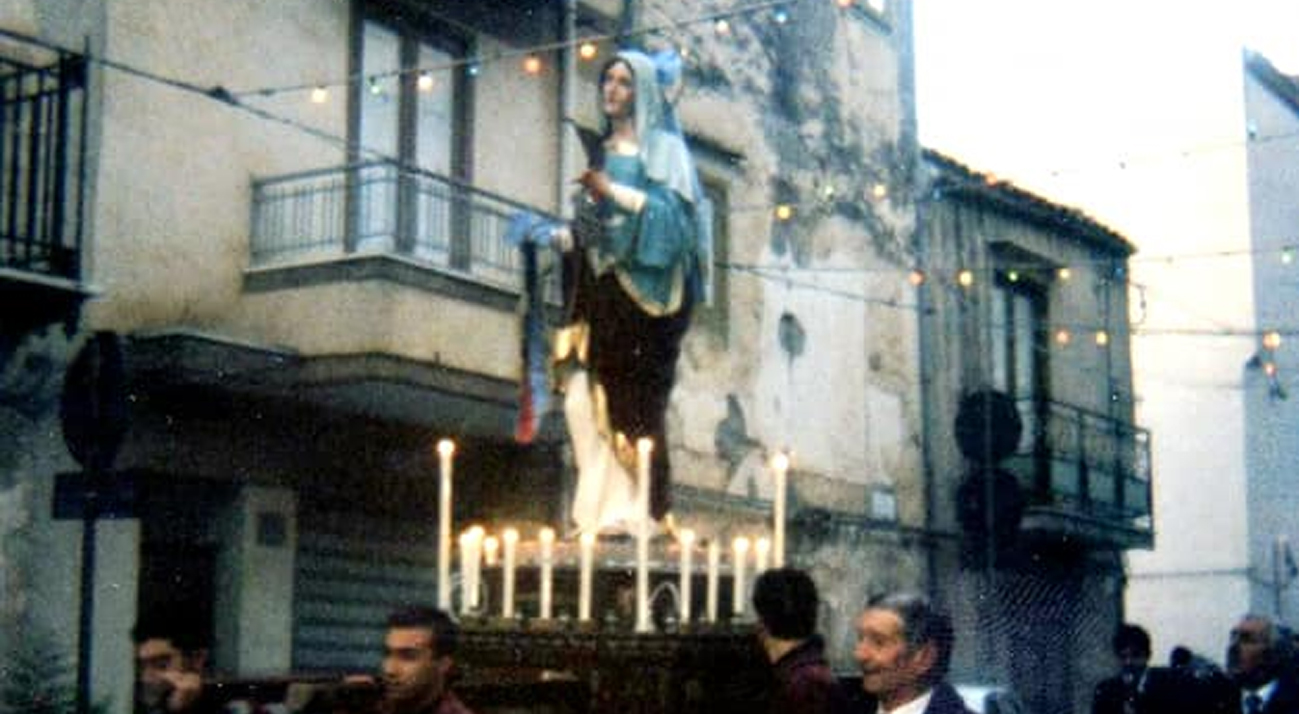Your basket is currently empty!
Devotion to Saint Lucia
After the feast of the Immaculate Conception, there’s another important anniversary on December 13: the feast of Santa Lucia, a Sicilian virgin and martyr. Sicilian people consider December 13 as a significant date, not only because it’s considered as the longest night of the year but also because it’s our “Virginedda”’s anniversary, the pride of Sicilian people.
Sicilian women address her affectionately and familiarly, calling her “Luciuzza”. Many are the devotees who say special prayers to her asking for grace. The Saint is often invoked to cure from eye disease. For instance, in Gratteri, Mrs. Nina Cirincione (born in 1913), recited this prayer:
“Santa Lucia supra lu munti stacìa, avìa na frasca all’occhiu ca c’è brindisi e finocchiu. Cu li manu la chiantai, cu li pedi la pistai, cu la vucca la binidissi, fai Lucia comu ti dissi”.
Mrs. Antonia Di Francesca addressed to her when she felt the presence of a foreign body in the eye, by tracing with her thumb the sing of the cross three times and by reciting the following prayer:
“Santa Luciuzza di lu mari, se è frasca facitila vulari, se è tierra facitila squagliari”.
Many are the devotees who feel they got a miracle from the Saint, just as stated by Mr. Giacomo Barca, the party organizing committee President. He declared in an interview that, during a work-related accident, he cut his right eye cornea, and he healed inexplicably, through the Saint intercession.
Even today the devotees in Gratteri cook cuccia (boiled wheatberries) and some devotional eye-shaped biscuits that, after being blessed, are split among the faithful to the mass by the organizing committee (among the several representatives of Santa Lucia committee, who have followed one another since 1950 to the present, are mentioned: Francesco Sideli, Salvatore Cannici, Giuseppe Fiorino and Giacomo Barca).
Salomone Marino had observed that: “‘the relationship between the Saint and wheat is established on the basis of a miracle: the landing of boats loaded with wheat in the city of Syracuse, exhausted by famine’. (Salomone Marino 1897, pp. 86-87).
According to hagiographic legend, this devotion to the patron saint of eyesight has its origins in the tradition of agricultural and pastoral Sicily. The Saint has often been related to the Greek goddess Demeter or the Roman Ceres, whose main attributes were the bunch of ears of corn and the torch. The boiled wheat, which the faithful eat as an offering, can be traced back to the ceremonial food that was also eaten in the mysteries of the Greek goddess.
And in addition, the expressions and names used to invoke the saint (‘light of the eyes, of sight’, ‘light of the world’) reveal not only a clear spiritual symbolism of great intensity, but especially that cosmological vision of past civilisations and modern peasant cultures in which light and night, life and death alternate, in a path whose circularity guarantees the eternal flow and return of things.
Propp says of the consumption of cooked seed: ‘The grain has the property of preserving life for a long time and reproducing it again by multiplying it in the earth. The well-known continuous seed-plant-seed cycle testifies to the eternity of life. Humans, by eating seeds, become participants in this process”. (Propp 1963, p. 47).
The iconography is strongly influenced by the episode of the tearing of the eyes as the Saint is depicted with a tray, in her right hand, on which her eyes are placed, while in her left hand she is holding a palm tree, symbol of martyrdom. Typical devotional testimonies are the band of ex-voto jewels, the palm in silver and gold, and the silver foils in the shape of eyes that adorn the simulacrum for the festivity.
The 13th of December was also considered a significant date because, in the small town of Madonie, women began to count the kalends until Epiphany. This 24-day period was divided into two blocks of twelve days each.
Each day corresponded to a specific month; thus 12 days for the 12 months of the year. Beginning with the 13th day, which corresponded to December – ‘Santa Lucia lu misi chi sia‘ – the count continued in ascending order: the 14th was January, the 15th was February and so on until Christmas Day: “Di Santa Lucia a Natali un passu di cani, di Natali all’annu nuovu un passu d’uomu“.The same count was carried out from 25 December to 6 January, but in reverse order, “a scinniri”: the 26th corresponded to November, the 27th to October, and the 6th to January.
The weather forecasts and the weather pattern for those days (which corresponded to the months of the year) determined the overall weather pattern for the months of the new year. Thus it could happen that “jnnaru, mienzu duci e mienzu amaru”, “frivaru piddaru, curtu e malu cavatu”, “aprili friddu suttili…” and so on. There are many testimonies collected over the years in Gratteri, a very important intangible heritage worthy of being passed on.
Verginella gloriosa
(canto devozionale intonato nella Chiesa di San Sebastiano)
Verginella gloriosa,
Di Gesù diletta sposa,
Nostra Madre e cittadina,
Gli occhi a noi dal Cielo inchina,
Dhe! Tu impetra al suol natio
La pietà del sommo Iddio.
Ah! Non cessa, e troppo infesta
Si dilunga la tempesta,
Che la tua, già un dì sì bella,
Siracusa ha reso ancella!
Ah! Quel capo al serto avvezzo,
Or calmato dal disprezzo,
Chino al suol con rase chiome,
Fa contrasto al tuo gran nome.
No, non vale da sciagure
A salvarla così dure,
Nè l’intatta fedeltà
Nè l’antica maestà:
Straziati dagli artigli
Del dolor mira i suoi figli:
Que’ che vedi all’ara chini
Son pur tuoi cittadini
Se la patria abbiam comune,
D’ogni mal la rendi immune;
E quando fummo qui nel mondo,
Fa che l’alma, poi che il pondo
Deporrà de l’uman velo,
Cittadini torniamo in cielo.



